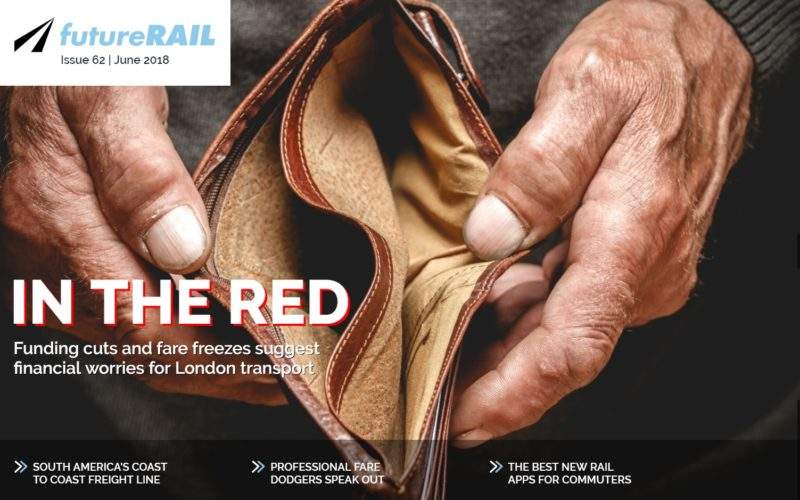
Money is a key concern for rail operators and commuters alike, and in this issue we focus on finances. In the UK, Transport for London is coming under increasing financial pressure following talk of fare freezes and funding cuts, and here we explore how the company is creating enough commercial income to keep afloat, and if there’s cause for concern.
While in contrast, professional fare dodgers are joining forces in Stockholm, Gothenburg, Ostergotland and Helsinki and we speak to one of the key groups to find out why they believe public transport should be free and the lengths they go to break the rules.

Discover B2B Marketing That Performs
Combine business intelligence and editorial excellence to reach engaged professionals across 36 leading media platforms.
Elsewhere, the proposed Central Bi-Oceanic Railway Corridor coast-to-coast railroad is planned to stretch 2,333 miles along the Pacific to the Atlantic Ocean. We profile this mega project to see what trade benefits it could offer the countries involved and their neighbours. Also, we look at the best and worst major rail hubs across the world, see the unveiling of the Virgin Azuma – the UK’s most high-tech rolling stock launched to date – and round-up the hottest new rail apps competing for commuter attention.
Click here to read the latest rail industry news and analysis, and join the conversation on Twitter.
In this issue
Financial Trouble at TFL
TFL, London’s public transport provider, is under increasing pressure. Not only has the government operating grant been slashed but a funding freeze is also expected to cost £640m across the course of the current Mayoralty. Can TFL create the commercial income needed to keep it afloat or are there serious causes for concern? We find out.
Click to read
The Bi-Oceanic Corridor: rivaling maritime freight
The Central Bi-Oceanic Railway Corridor or ‘Panama Canal on Railway Tracks’ is a proposed coast-to-coast railroad across South America which aims to stretch more than 2,333 miles between the Pacific coast of Peru, through Bolivia and across Brazil to the Atlantic Ocean. The project, deemed to be one of the largest infrastructure projects of the century, has also sparked the interest of Paraguay, Argentina and Uruguay who plan to add connection routes to the corridor. We profile this mega project to see what kind of trade benefits it would present to the countries involved.
Click to read

US Tariffs are shifting - will you react or anticipate?
Don’t let policy changes catch you off guard. Stay proactive with real-time data and expert analysis.
By GlobalDataRevolutionising the UK’s East Coast railway line
First announced in early 2016, the new Virgin Azuma fleet of trains is due to enter service in December 2018. With Virgin claiming the train fleet’s introduction has the potential to be the most exciting chapter in British rail history, Elliot Gardner looks back at some of the updates that we’ve seen from Azuma over the last two years.
Click to read
The best and worst major rail hubs
An Australian design consultancy has revealed its 2018 Mobility-Oriented Development (MODe) benchmarking index, revealing the best and worst of the world’s busiest railway stations, based on the company’s criteria of connectivity, urban environment, social place-making and economic development. With the likes of New York’s Grand Central Station, Paris’s Gare du Nord and Hong Kong’s HKU Station near the top, and Sydney Central Station, Santiago La Cisterna and Los Angeles Union Station near the bottom, we profile the best and worst of the world’s major rail hubs.
Click to read
Tapping into the top rail apps
The growing popularity of smartphones has led to the creation of new apps that are changing the way passengers purchase tickets, plan journeys and communicating with rail operators. From route planners to train simulators, what are the app concepts that are making life better for passengers and rail enthusiasts?
Click to read
Stockholm’s professional fare dodgers
In Stockholm, Gothenburg, Ostergotland and Helsinki, some commuters are taking the initiative in the way they navigate and pay for public transportation: by banding together to avoid fares. One of the groups believes public transport should be free and has tried and tested several methods of fare dodging, and even put in place a sound monetary system to cover any potential fines. We talk to one of these groups to find out more about their ideology and methods.
Click to read
Preview – Future Rail July
DB Cargo has committed to digitalising its freight wagon fleet by 2020. The huge project will involve fitting around 70,000 wagons in Germany with state-of-the-art sensors and telematics systems, which will not only enable wagon tracking and arrival time prediction, but provide information about occupancy, temperature and humidity levels of wagons. We find out about the technical challenges involved with a project of this scale, how it will boost operations, and the outlook for digitalising rail freight and cargo across the industry.
In infrastructure, we catch up with the 18km Denmark to Germany tunnel as it approaches the construction phase and consider its potential to influence the economies and socio-political relations, find out if the UK is likely to regret its decision to ditch its three rail electrification projects, and hear what’s being done to upgrade New York subway’s ageing signalling system.
Elsewhere, we take a deep look into the 165 years of Indian Railways and the heritage of the company, from the days of the British Raj to becoming a modern-day superpower, examine the controversy of France’s President Macron reforming the SNCF and whether this is the first step towards privatised national rail.





